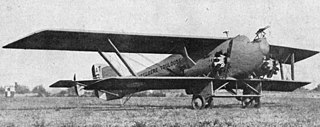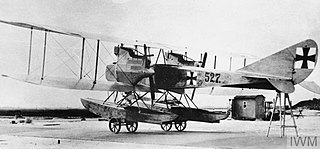
The Zeppelin-Staaken R.VI was a four-engined German biplane strategic bomber of World War I, and the only Riesenflugzeug design built in any quantity.

The Siemens-Schuckert R.II was a prototype bomber aircraft built in Germany during World War I. It was one of six aircraft based on the Siemens-Schuckert R.I that were originally intended to be identical, but which each developed in a different direction and were designated as different aircraft types by the German Inspectorate of Flying Troops. Although the R.II was the first of the batch to be completed, it was the last accepted into military service, and then only as a trainer.

The Latécoère 6 was a French four-engined biplane bomber of the early 1920s. It was of advanced all-metal construction and probably the first aircraft to use geodetic construction. Only one was built.

The Zeppelin-Staaken Riesenflugzeuge were a series of very large bomber aircraft - Riesenflugzeuge, usually powered by four or more engines, designed and built in Germany from 1915 to 1919.

The Zeppelin-Lindau Rs.II was a biplane flying boat, designed by Claudius Dornier as a follow-on to his Zeppelin-Lindau Rs.I and built during 1914–1915 on the German side of Lake Constance. Initially this aircraft was powered by three engines mounted inside the hull driving three pusher propellers via gearboxes and shafts. The later version was powered by four engines in two push-pull nacelles mounted between the wings.

The Zeppelin-Lindau Rs.III was a large four-engined monoplane flying boat designed by Claudius Dornier and built during 1917 on the German side of Lake Constance at the Zeppelin-Lindau works.

The LFG Roland D.IX was a World War I German single seat fighter aircraft, a biplane powered by one of a new generation of powerful rotary engines. Three slightly different prototypes were built but there was no series production.

The LFG Roland D.XV was a World War I German single seat fighter aircraft, ordered as a test-bed for engine comparisons. It was distinguished from earlier Roland biplane designs by the elimination of flying wires. Two later aircraft, also called LFG Roland D.XV, were completely different designs with slab sided fuselages.

The LFG Roland Pfeilflieger, (Arrow-flyer), was a German swept wing, single engine, two seat biplane built in Germany in 1914. It made one distinguished long duration flight and served in colonial German South-West Africa.

The LVG G.III was a large, twin engine triplane bomber built in Germany near the end of World War I. Only one was completed.

The Schütte-Lanz G.I was a large, twin engine, pusher configuration, experimental biplane built in Germany early in World War I. Only one was completed.

The Albatros W.3, company designation VT, was a biplane torpedo bomber floatplane prototype, built for the Imperial German Navy during the First World War. Only one was built.

The Siemens-Schuckert L.I was a large, three-engined biplane bomber aircraft, built in Germany towards the end of World War I. It was a twin boom design, strongly influenced by the successful Caproni Ca.3. Three were built but not used operationally.
The Caproni Ca.61 was an Italian heavy day bomber aircraft of 1922. It was the final development of the Caproni three engine, twin boom biplane types developed during World War I, but it was not put into production.
The Polikarpov PM-1 was a passenger aircraft created by Polikarpov in the 1920s.
The LFG V 8 Bärbel (Barbel) in English) was a small, single-engined, biplane flying boat which carried two passengers. The sole example was built in Germany shortly after World War I but was exported and used for Baltic flights.

The Zeppelin-Lindau Gs.I, often known post-WWI as the Dornier Gs.I after its designer Claude Dornier, was a civil flying boat developed immediate post-war from a military prototype. Its passenger cabin seated six. Only one was completed, and that was eventually scuttled to keep it out of Allied hands. Another of the military prototypes was intended to have a bigger, nine seat cabin and other refinements but the Gs.II was incomplete when discovered by Allied inspectors.

The Zeppelin-Lindau V I was a metal-framed, pusher configuration, German sesquiplane, designed by Claude Dornier. It flew on 13 November 1916 and crashed on the first flight.
The Kawanishi K-10 Transport was a 1920s Japanese passenger and mail transport. Two were built, one briefly serving a route between cities in Japan, Korea and China.
The Kawanishi K-3 was a Japanese, fast, multi-purpose civil transport aircraft from the early 1920s. Despite its good performance it was eclipsed by the release of Army surplus machines and only one was built.














